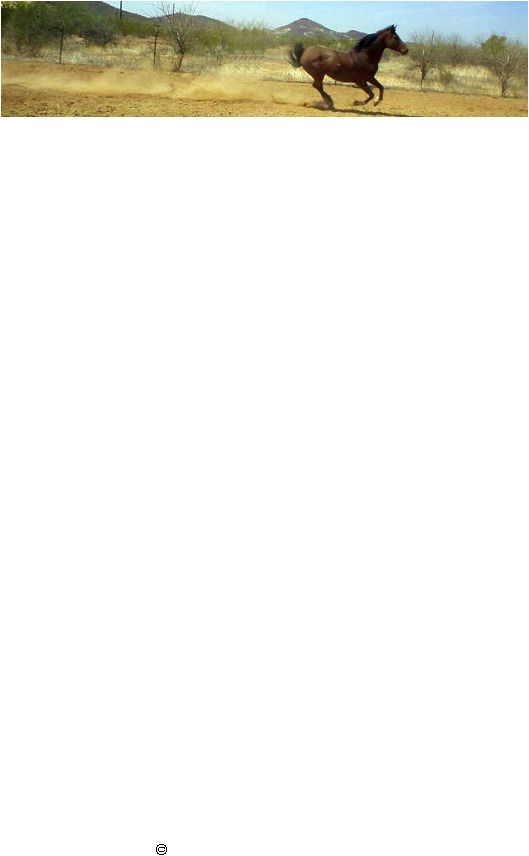
the archetypal mythology of horses
Copyright
2004-2021
Beverley Kane, MD
Page 1 of 20
DAY MARES AND NIGHT STALLIONS
—
ARCHETYPES IN THE MYTHOLOGY OF HORSES AND HORSE DREAMS
by Beverley Kane
PART I
–
MYTH
,
ARCHETYPE
,
AND SOMARCHETYPE
Myths are the dreams of the race.
Dreams are the myths of the individual.
Sigmund Freud, Dreams and Myths, p. 73
[…]Excellent dream work can be done whether or not one knows these
myths and folk stories. When the dreams call up archetypal images, the
unconscious dreamer already knows what the basic story is, whether or not
the interesting parallels to sacred narratives in other distant and obscure
cultures are immediately available to consciousness. The universal themes
can be discovered by "ordinary" explorations of the images for their personal
associations and basic symbolic implications. The archetypal amplifications
drawn from knowledge of the religious and folk traditions of other cultures
enrich the work; but they are not necessary, since the same essential
symbolic dramas and relationships can be revealed by the dream images
themselves, even without their specific archetypal associations.
Jeremy Taylor, The Living Labyrinth, p 107-8
THE LIVING MYTH
Speed. Strength. Grace. Power. Beauty. Every physical horse is a living myth unto its
beholder. We do not require a book of fairy tales or a Joseph Campbell to articulate the
|
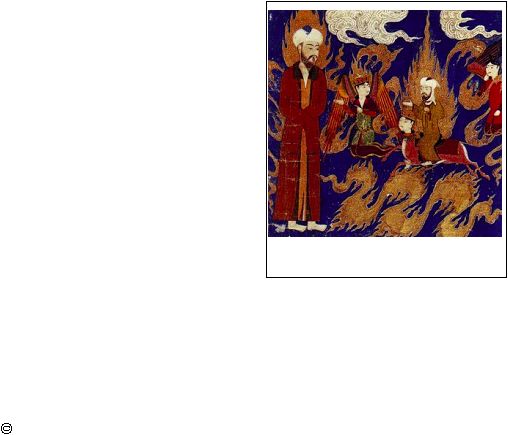
the archetypal mythology of horses
Copyright
2004-2021
Beverley Kane, MD
Page 2 of 20
deep personal awe we feel in the presence of Horse. To see, smell, touch, fear, and
mount a horse in the flesh is to feel the stirrings of archetypal energies arising from at
least 35,000 years of human awareness of Horse.
When we encounter Horse in waking life, she already possesses a dreamlike
quality. When we encounter Horse in dreams, we apprehend the living myth in
manifestations that are easily related to the magic she evokes in waking life. In She Flies
Without Wings: How Horses Touch a Woman's Soul, Mary Midkiff says, "A horse's
body and limbs are not just palpable but symbolic, not just functional but suggestive."
The nature of myth as something larger than life, a story on steroids, begs for
protagonists that, like Horse, are literally—and so figuratively—more momentous than
ourselves.
For contemporary cultures no longer dependent on the horse for food, draft, or
transportation, the living horse has ceased to be part of daily experience. If we see him at
all, it is in parades or mounted patrols, from a car window on a drive in the country, in
televised sports, or, uncommonly, as an aide in hippotherapy, therapeutic riding, equine-
assisted psychotherapy, and equine experiential learning.¹
The mundane associations having receded from our experience, what is preserved
and magnified are Horse's mythic qualities. Urban children become familiar with Horse
mainly through folk and fairy tales, movies and television. For them, only a mythical
relationship to horses exists. Yet even children who grew up on farms with horses retain
a sense of wonder and love for them. When Horse enters our dreams, her magical
qualities emerge whether or not we are currently in a relationship with a waking life
horse.
Most folk tales portray Horse as
extending the physical abilities of his rider and
so becoming an accessory to the Hero's quest.
He is literally and figuratively a means of
transport across the terrain of the tale's setting
and into the internal landscape of the Hero's
journey of self-discovery and awareness. In
Egyptian, Greek, Armenian, Norse, and Hindu
mythological traditions, horses pull the sun (and
sometimes the moon) across the sky. Al Borak,
a horse with the head of a woman and the wings
of an eagle, raises Mohammed to Seventh
Heaven. Bucephalus, a horse mythically
enhanced from historical record, carries
Alexander the Great into victorious battles.
Gods and goddesses such as Diana, Epona, and
Odin rode horses. So too, did Hades, god of the
Underworld, on his steeds Nonios, Abaster, and Abatos.
In the Rig-Veda of 3000 BC several references are made to the Aswin, the twin
sons of the sky Dyaus, and brothers of Usha the Dawn. The Aswin were gods with horse
heads and their sister Usha brought forth the dawn on her horse-drawn chariot. The Book
Mohammad ascending to
Seventh Heaven on Al Borak
|
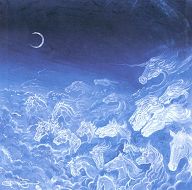 the archetypal mythology of horses
Copyright
2004-2021
Beverley Kane, MD
Page 3 of 20
of Revelations in the New Testament foretells the Four Horsemen of the Apocalypse
who will usher in the end of the world, the second coming of the Messiah, and God's
vanquishing of all evil. Muhammad, Vishnu, and Christ are all prophesied to return on a
white horse.
In many tales, Horse is an independent agent who corresponds to a singular
physical or psychological type. Pegasus alone stood among the Greek pantheon as a
god, sprung from the sea god Poseidon and the bleeding head of Medusa. Pegasus was
sacred to the Muses, and from his hoof sprang the Hippocrene fountain whose waters
conferred the gift for poetry in those who drank from it. No one was able to mount
Pegasus before Bellerophon sat astride him.
Bellerophon could not tame Pegasus until Athena
visited him in a dream. She handed him a golden
bridle and bade him ride Pegasus to defeat the
monstrous Chimaera. When Bellerophon awoke, he
held the golden bridle in his hands. Thus the bridling
of Pegasus symbolizes the rationality of Athena,
goddess of Wisdom, overcoming the instincts and
uncontrollable passions, represented by Pegasus in
his wild, unbridled state. The story also links the
dream world to the waking world. We are reminded
of our ability—the necessity—to use will and reason
to manifest in the physical the gifts from the seemingly chaotic, ephemeral, and
disconnected world of dreams, instincts, and imagination.
When we tell stories such as Good Luck Horse, Bad Luck Horse, recounted
below, we endow Horse with his own agency. When we examine horses in the dreams of
contemporary people, we will note whether they act as free agents or as physical
extensions of the dreamer.
ARCHETYPES AND PROJECTIONS OF MIND AND BODY
PSYCHOLOGICAL ARCHETYPES
Archetypes (Greek arche, original or beginning + type, form or pattern) is the Jungian
term for the blueprints for human personality and character essences that exist across all
cultures, throughout all time, in every individual. They are the straight-from-central-
casting roles that each society clothes in its own customs and prejudices—loving mother,
wise old man, beautiful princess, knight in shining armor, evil fiend, god and goddess,
beloved baby animal.
The entire cast of archetypes performs in every human psyche, usually in the
wings where we are unaware of them. Each of us is an omnipotential personality,
capable of expressing every archetype. Myths, folk legends, and fairy tales—remarkably
similar in all languages and cultures—are stories built around archetypal themes. Noting
|
|
the archetypal mythology of horses
Copyright
2004-2021
Beverley Kane, MD
Page 4 of 20
these cross-cultural similarities, twentieth century psychiatrist and mystical intellectual
Carl Jung postulated a collective unconscious—the universal repository of all human
beliefs, knowledge, patterns, and experience that has not come to conscious awareness.
The collective unconscious is like a library of millions of books that taken together
reveal the infinite possibilities for the past, present, and future of the psyche. Taking
books out of the library is the act of making unconscious patterns and beliefs become
conscious.
Archetypal dramas come to us in folk tales and in night time sleeping dreams.
We also see them in waking dreams, those highly symbolic or highly charged events that
seem to happen to us—our triumphs, tragedies, lucky breaks, “accidents,” and illnesses.
In Jungian psychology, the work of a lifetime is the process of individuation in which
one attempts to integrate all the archetypes into consciousness of the Whole Self. In this
process, and in common with the mystical traditions of every world religion, we
recognize the fundamental unity of all beings and all experience.
To the extent that we have not acknowledged, embraced, and integrated all
possible archetypes within our own psyches, we will forever project them outward onto
others. Projection is the act, often unconscious, of attributing or blaming one’s feelings,
thoughts, circumstances, and attitudes to or on other individuals, racial or ethnic groups,
or animals. Everything we experience as otherness, external to ourselves, represents, in
part, a projection of our internal states upon our mates, parents, children, enemies,
heroes, and animal companions. When our unconscious projections lead to hateful
emotions, destructive behaviors, or dangerous infatuations, we damage our relationships
and ourselves. When we read myths and folk tales, we can harmlessly project our
unacknowledged archetypal roles onto the heroes, lovers, villains, and animals of fiction.
Children do this quite naturally and playfully by becoming monsters, witches, and fairy
princesses for Halloween.
In myth and folk tale, whether idolized or demonized, Horse appears in forms
that correspond to all the major Jungian archetypes we meet below—Anima and Animus
(Gender Complement), Dark Shadow and Bright Shadow, Trickster, Hero, and Willing
Sacrifice.
ARCHETYPES OF THE PHYSICAL BODY
Archetypes as Jung defined them are psychological concepts that press down like
cookie cutters on the dough of our personality and character. However mental constructs
are insufficient to represent all our projections onto Horse. We also project onto him our
nonverbal sensations of size, strength, balance, grace, coordination, agility, and speed.
The body has its own unconscious material that needs to be integrated into the Whole
Self. As is attested to in research on cellular memory and in some sudden changes in
personality in organ transplant recipients, the body has its own consciousness.² Like
concepts of intuitive empathy, mental telepathy, and emotional sympathy, we can
postulate a somatopathic function that is body-to-body. Just as tendon reflexes like the
knee-jerk reaction are mediated by the spinal cord and do not need the brain,
somatopathic projections are not relayed via the cognitive brain for their enactment. If
|
 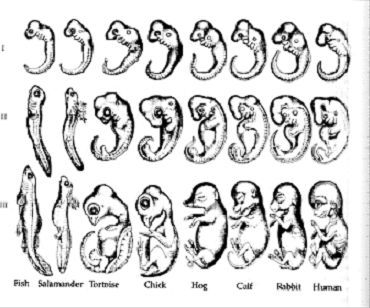 the archetypal mythology of horses
Copyright
2004-2021
Beverley Kane, MD
Page 5 of 20
you have ever found yourself involuntarily and almost unconsciously bobbing your head
to a jazz beat, you've experienced a somatopathic response to the music.
Physical qualities are not adequately addressed in psychological archetypes.
Physical archetypes are separate but equally primal and universal. They exist in the
language of visceral repertory that the body understands on its own terms.
The body
does not merely react to ideas. It has its own primary apprehension and response. Martial
arts teach us that our mental states can be secondary to how we center, balance, and
move our bodies.
Let us suppose the existence of somarchetypes of the physical body's universal
primordial experiences.
*
The forms, shapes, and sensations experienced as Other, both
animal and human, receive projections from the sensory unconscious. In waking life and
in dreams, we project somarchetypes onto animal bodies and probably onto plants and
inanimate objects as well.
†
We project our imagined versions of tallness and shortness,
strength and weakness, skinniness and fatness, baldness and hairiness, vaginas and
penises, onto those who have attributes unlike our own but known to the collective
physical unconscious of which
we are part. We project our
undesirable, rejected Dark
Shadow somarchetypes onto
disabled or disfigured forms.³
We project our desirable, ideal
Bright Shadow somarchetypes
onto Olympic athletes, beautiful
ballerinas, and horses.
When we dream of
animals, one layer of the dream
is the dream body representing
itself as an earlier stage of our
physical development. The
memory of these forms is stored
over the millennia of evolution in
the consciousness of our cells.
A now largely discredited
theory of human embryonic
development states "ontogeny recapitulates phylogeny."
‡
In the figure to the right,
executed, some say fraudulently, by late the late 19th century German biologist, Ernst
Haeckel, the human fetus in its nine months of development passes through forms that
resemble stages of evolution—from fish to amphibian to bird to "lower" mammal to
*
From Greek soma-, body. The term somatype might have been preferable, however it was already used
in the early 1940s by American psychologist William H. Sheldon to describe ectomorphs, mesomorphs, and
endomorphs.
†
Hence we have the Gestalt technique of being all characters and objects in our dreams.
‡
This concept means that the gestation, or coming into being (ontogeny), of each "higher" animal passes
through all the stages of evolution of each kind (phylum) of "lower" animal.
Ontogeny recapitulates phylogeny. Ernst
Haeckel, 1868.
|

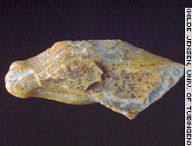 the archetypal mythology of horses
Copyright
2004-2021
Beverley Kane, MD
Page 6 of 20
"higher" mammal.
In an analogous way, oneirogeny—the
creation of dreams by the dream ego—recapitulates
mythogeny. That is, dreams reënact the history of
myth and replay the primitive, modern, and universal
dramas of myth, legend, and fable. We dream
ourselves in more primitive physical as well as
psychological forms. Scenarios of animals behaving
idiosyncratically and other fantastic dream scenarios
lend the power of myth to our night dreams. That is
what Freud meant when he said, "Myths are the
dreams of the race; Dreams are the myths of the
individual."
EVOLUTION OF THE ARCHETYPE—FROM DARWIN TO DISNEY
Horses evolved 60 million years ago as Eohippus, a 4-toed, leaf-eating forest dweller
with approximately the habitus of a medium-size dog. Today's horse, Equus caballus,
has been known for 20 million years. Late Paleolithic (-35,000 to –8000
*
) humans
hunted wild horses for food, evidently used them in ritual, and vividly depicted them in
cave art found all over Europe and, from a later period, in Asia Minor.
As an herbivore, the horse preys on no other animals, but is itself the target of
predators such as large cats and wolf packs. Most horses take flight under stress, but
when domesticated for ranching and battle, have been known for their bravery,
aggression, and selflessness. Some historians have proposed that the horse was first
domesticated by migratory reindeer herders in Northern Europe, who by –5,000 rode
reindeer and hunted horses, and somewhat later by the Proto-Indo-Europeans on the
Ukrainian steppes.
Beginning in the -3rd millennium, and over a period of 3,500 years, pastoralist
horse peoples from the Pontic-Caspian steppes began a methodical migration into
Europe, Anatolia (current day Turkey), the Indus region, and Western Siberia. The new
settlers underwent in part a syncretic absorption of the agrarian and mercantile native
societies. There is also archeological evidence of horse and chariot warfare, whereby
invaders forcefully conquered indigenous populations. In essence, the horse evolved
from a draft animal, to a warrior's steed—both harnessed to chariot and mounted—to a
form of general transport.
4
As the horse evolved in relation to humans, from food source in –35,000 to
domesticated laborer in –5000 to warrior steed in -2000 to sporting companion, he
appeared in different roles in myth and projection. We can only wonder what the
Lascaux cave artists were thinking in –14,000 when they painted horses inside the caves.
Were they thinking in terms of art for art's sake, religious iconography and ritual, or
*
Negative numbers designate dates "Before Christ" or "Before the Common Era."
Ivory carving of a horse
found at Hohle Fels Cave
in southern Germany. –
33,000
|
 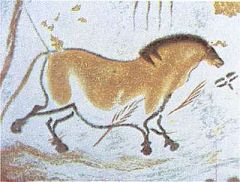 the archetypal mythology of horses
Copyright
2004-2021
Beverley Kane, MD
Page 7 of 20
dinner?
5
By the first millennium, numerous
cultures abound with myths, folk tales, and
rituals involving the horse, including a form of
horse suttee—where horses were buried with
their masters.
Until recently, horse tales were told by
and to people who were familiar with physical
horses in daily life. In the age of the tractor and
the automobile and the snowboard, horse myths
are spread by the mass media to people,
especially children, who have little or no contact
with live horses. Old movies such as National
Velvet, the Black Stallion, Ben Hur, and Equus, and newer movies such as Spirit, Lord of
the Rings, Seabiscuit and Hidalgo proffer mainly archetypal images to a new generation
of dreamers.
The following sections describe the most significant Jungian archetypes and how
the horse portrays each archetype in mythology.
ANIMUS/ANIMA/GENDER COMPLEMENT
Animus and anima are the archetypal figures that hold, respectively, masculine and
feminine qualities. Masculine, or yang, qualities are traditionally active, penetrating,
aggressive, assertive, hard, dominant and rational. The feminine, or yin, is associated
with passivity, acceptance, nurturing, receptivity, envelopment, softness, and intuitive
processes.
In Jung's time, the animus was a woman's "inner man" and the anima was a man's
"inner woman." In a predominantly heterosexual society
*
conditioned by the persistent
influences of the 20th century, Jung's definitions remain relevant and useful in the
interpretation of dreams and myths. But because masculine and feminine do not
necessarily equate with or attach to biological males and females, and because there are
so many variations of intergender and transgender identities, the term gender
complement denotes the set of opposite or missing gender qualities that complete each
individual. Strong projections onto one's gender-complementary person are often
experienced as sexual attraction or falling in love.
One of the more remarkable aspects of a living horse is that he dually expresses
both strong masculine and strong feminine qualities. On one hand the horse's physical
powers suggest the strongman figure whom Jung's student Maria-Louise von Franz uses
to exemplify the wholly physical man, one of the four stages of the animus.
6.7
On the
other hand, in The Tao of Equus, Linda Kohanov claims that horses relate to the world
*
Demographers estimate that between 5 and 9 percent of the US population self-identify as gay, lesbian,
bisexual or transgender—Harris Interactive www.harrisinteractive.com/pop_up/glbt/ 2004
Cave drawing at Lascaux,
France. –14,000
|

the archetypal mythology of horses
Copyright
2004-2021
Beverley Kane, MD
Page 8 of 20
from a primarily feminine, or yin, perspective:
As a result, the species is a living example of the success and effectiveness
of feminine values, including cooperation over competition, responsiveness
over strategy, emotion and intuition over logic, process over goal, and the
creative approach to life that these qualities engender.
Especially when gender-based philosophies such as feminism, as in Kohanov's
case, are the framework for one's observations and interpretations, it is tricky business to
map masculine and feminine onto men and women, much less onto mare, gelding, and
stallion. Labels aside, we observe that horses exhibit behaviors that, even within a single
horse, seem to be paired opposites: big and strong, yet shy and fearful—always a prey
animal, never a predator; stubborn and headstrong yet willing and large of heart; hardy
yet sensitive; easily domesticated and trained, yet (except when abused) forever wild,
free, and unpredictable; quick to take "offense," yet immediately forgiving.
In equine-assisted psychotherapy and equine experiential learning, patients and
participants are frequently, and usually unconsciously, drawn to horses that mirror some
aspect of the person's gender-complement relationships. These affinities, which can be
mutual from the horse's point of view, often enact the archetypal dramas of the human
relationships. For example, Kohanov presents the case of a smart-women-foolish-
choices type of client named Joy. In Joy's initial equine-assisted psychotherapy session,
she has "an overwhelming attraction to a horse who mirrored the traits of aggressive men
in her life, and [an] initial inability to recognize the danger this horse represented."
A striking enactment of the anima/animus dynamic with horses was the elaborate
and, to the modern mind, gruesome and grotesque ritual of the asvamedha and its Roman
derivative, the October Equus. Dating from thousands of years ago, and last performed
in the 18th century, the asvamedha is described in the Rg Veda as the merging with—in
some retellings, copulating with and then devouring—the sacrificial horse.
*
In this ritual, a stallion is set free for the period of one year. It roams far and
wide, accompanied by 400 of the king's warriors who assure his freedom to wander at
will and at the same time prohibit him from mating. At the end of the year, the stallion is
ritually killed and the king's favorite wife is placed under wraps with him. She lies with
the dead stallion for a full day and mates with him. The next day, the stallion is
dismembered into three parts –for each of three classes of society: warrior, priest, and
herder-cultivator—and roasted. Portions of the meat are sacrificed to the gods and
portions are eaten. Thus the king's wife not only ritually integrates her own animus
archetype of male potency, but the king himself courts power, fertility and abundance
vicariously through his living anima.
T.C. Lethbridge describes the complementary ritual, which he personally
witnessed in Ireland in the 17th century, wherein the king physically mates with a mare in
an enactment of union with the Divine Sovereign Goddess. In this Ulster ritual, the mare
is also divided into three parts, which are boiled to form a broth in which the king bathes
and which are then consumed.
*
The Proto-Indo-European root word ekwo-meydho, or horse-drunk, contains the root of our word "mead"
as an alcoholic beverage, and suggests that such horse rituals antedate even the antiquity of the Vedas.
|
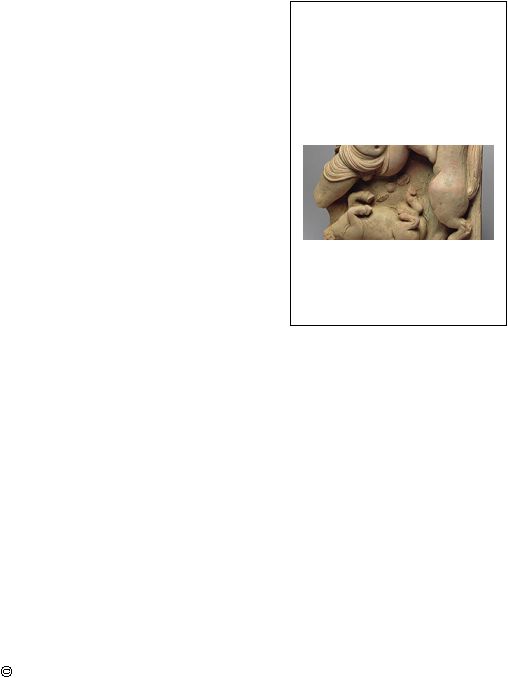
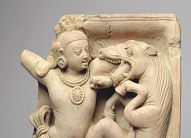 the archetypal mythology of horses
Copyright
2004-2021
Beverley Kane, MD
Page 9 of 20
Both the Vedas and the Celtic myths relate the deeper significance of physically
mating with and devouring the horse. The act is not just a fertility rite, but the union with
the Divine. In an essay on the Universe as a Sacrificial Horse, Swami Krishnananda
describes the elaborate rituals of the Brihadaranyaka Upanishad in which the horse of the
asvamedha sacrifice is the object of consecration and meditation. In this Upanishad, the
horse "becomes a piece of contemplation which is the avowed purpose of the
Upanishad—to convert every act into a mode of contemplation, to transform every
object into the Universal Subject." In effect, the mating of anima and animus in our
personal relationships is a ceremony of ecstatic union with the divine,
Throughout the amateur equestrian world, there is a marked preponderance of
girls and women. During the lunch break at a local
horse show, one dad and I were noting this gender
imbalance as we watched his 12-year-old daughter
compete in her all-girl class. I asked him, "Why do
you think this sport appeals so much more to girls?"
He shrugged and replied, "They want something
powerful between their legs." Whether or not this
rather wan and nerdy Silicon Valley type was
experiencing strong projections of his own anima,
there is probably some truth to his assessment.
There is certainly some appeal for girls and women
of commanding and merging with a 1200-pound
beast who holds for us a certain animus archetypal
attraction and the somarchetypal attraction of
strength and power.
DARK SHADOW
Dark Shadow is the archetype that holds our rejected qualities such as "evil," violence,
ignorance, ugliness, weakness, decrepitude, and barbarism. When we fear we have these
qualities or have not recognized their positive alter egos, we project them onto our
enemies and villains, the "axis of evil," a despised relative or colleague, a race, nation, or
class of people.
8
Horses that are portrayed as behaving demonically, as if motivated by evil or ill
will, carry Shadow energy for the human race. In keeping with the gentle nature of
waking life horses, there are relatively few stories of mean, savage horses. In fact, most
horses in such tales derive their demonic qualities from shape changing gods, such as
Keshi or from their riders, who, like the Four Horsemen of the Apocalypse, are
themselves identified as the Devil or an evil witch.
The illustration on the right depicts an episode from the early life of the god
Krishna, an incarnation of Vishnu, who periodically descends to earth to battle the forces
of evil. Here Keshi, a mighty demon in the form of a horse, has been sent to destroy
Krishna. The combatants glare at each other, eyes bulging: Krishna's from the intensity
Krishna battling the horse
demon Keshi. 5th century.
Uttar Pradesh, India
|
 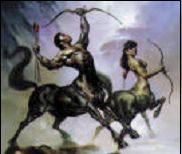
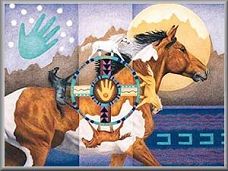
the archetypal mythology of horses
Copyright
2004-2021
Beverley Kane, MD
Page 10 of 20
of resolve, Keshi's from the surprise of defeat, indicated by the corpse of his horse
below.
Centaurs, a hybrid race of horse and human, are
known for their barbarism. We must conclude that the
centaur's directives, coming from its head, are human.
While some centaurs, notably Chiron and Pholus, were
benevolent, most are depicted as having atrocious
appetites for debauchery, especially with liquor and sexual
intercourse. Centaur myths often feature them drunk and
attempting to abduct women.
In seasonal street parades in the British Isles, men
dressed as horses chase women as part of the pantomime.
The most famous of these festivals is the May Day antics
of the 'Obby 'Oss at Padstow in Cornwall. Men dressed as a full-skirted horse attempt to
capture women under the folds of cloth. To be caught in such a way is supposed to bring
a pregnancy to the married and a fine husband to the single miss. The frolic relates to the
horse as a fertility (and perhaps potency) symbol who, as in the asvamedha rites, also
ensures a rich harvest. Thus a woman's worst nightmare of a being molested by a
Shadow figure is transformed into an enactment of potency and fulfillment with an
Animus figure. In fact, all archetypes show protean forms that merge and shift and
become one another.
BRIGHT SHADOW/THE DIVINE/HERO
Bright Shadow is the archetype that holds our esteemed qualities such as goodness,
rightness, intelligence, creativity, beauty, entitlement, talent, and power. When we fear
we do not have these qualities, or are blocked by our inhibitions from acting on them, we
project them onto movie stars, elite athletes, heroes, gods, saints, and pets or totem
animals.
Most horse myths are tales that depict horses in heroic deeds of strength, speed,
and endurance. While many of these stories portray horses in battle, there is a delightful
legend from China, thousands of years old, where the horse acts as a different kind of
hero.
In this story, The Good Luck Bad Luck
Horse, a lonely little boy, the son of a man
wealthy with horses, longs for a horse of his
own. The stern Father will not give the boy a
horse, so he makes one out of paper. A wizard
hears the boy's wish for a real horse and
makes the paper horse come alive. But
because the boy forgot to draw eyes on his
horse, the little pony cannot see. It proceeds to
blindly stumble through the Father's garden,
trampling everything in its path. The Father banishes the horse, whereupon the wizard
Centaurs
|
|
the archetypal mythology of horses
Copyright
2004-2021
Beverley Kane, MD
Page 11 of 20
takes pity on him and gives him the power both to see and to fly.
The horse flies off, finds a wife, and after many years returns to the little boy,
who is now a grown man in a kingdom on the verge of war. The horse and his mare fly
off to the battleground and speak to the horses of the enemy soldiers. All the horses
collude to bring the warring armies together in the river, where they cannot shoot
eachother but get tossed into the water and can only laugh at themselves.
After peace breaks out, the horse and mare return to the kingdom of the boy-
become-man and his Father. The little horse has proven his worth and everyone lives
happily ever after. So the horses, onto which the small boy projects his hopes and
dreams, come home to roost.
The somarchetype of the horse captures our strongest Bright Shadow projections.
When I watch horses galloping across a field or bursting forth at turn out, I long for a
tiny part of that energy and strength. My body attaches itself to the powerful movement.
Whether we envy their physical prowess or idolize and idealize them as noble savages,
we are prone to investing horses with that which we yearn for and cannot fully attain.
Many myths and dream images portray Horse as the vehicle for mythical journeys and
magical powers.
TRICKSTER
The Trickster archetype holds the imp sitting on our shoulder who says, "Lighten up.
Think different. Let go." He opposes the subpersonalities who are stubborn, serious,
morbid, doctrinaire, addicted to stability and terrified of change. He attacks our fixed
ideas and our attachment to the way things are. Trickster seeks to undermine our pride,
especially when it is vested in a static self-image that stunts our spiritual growth.
Because duplicity and chicanery are generally considered unethical in Western
society, the Trickster archetype of the used car dealer or the fox is often met with the
same antipathy as is felt toward the Shadow. But Trickster is the fellow who can get us
to laugh at ourselves. He is the voice of a black person using the "n" word to his brother;
he is why we pay extra to sit in the front row at comedy clubs and get harassed by the
headliner; he is why kings had court jesters. The fool in Shakespeare is particularly
aware of when his king crosses a moral line and is in the play to remind the king of his
own folly with thinly veiled derision.
Unlike Shadow with whom we can more or less choose our skirmishes, Trickster
comes to us unannounced and on his own terms. He is the great cosmic banana peel of
the unconscious. We let him in by giving him something to work with—our hubris, our
conscious and unconscious assumptions, our prejudices, our fears, our puffed up images
of ourselves. He creates a stampede among our sacred cows when they have outlived
their usefulness or tied up our energies in old structures and systems that need to be
overturned and overhauled. Trickster forces us to break out of our stereotypes and our
boxes, whether they've been imposed by our families, our culture, or ourselves.
Carl Jung states that the trickster archetype is "a primitive cosmic being of
divine-animal nature, on the one hand superior to man because of his superhuman
|
|
the archetypal mythology of horses
Copyright
2004-2021
Beverley Kane, MD
Page 12 of 20
qualities, and on the other hand inferior to him because of his unreason and
unconsciousness." This description helps explain why in mythology, Trickster often
appears as animals—Coyote, Blue Jay, Raven, Spider, Snake, Monkey, and Horse.
The horse as Trickster abounds in Celtic folk tales, where horses take the form of
shape-shifting water horses such as the Irish Each Uisge (ach (horse), ish-kee (water)) or
the Scottish Kelpies. Typically the water horse wears a golden bridle that appeals to
human greed. Although travelers are warned not to trust horses that appear at rivers and
lakes, the weary human wants so badly to believe in the human that promises easy
passage across the water. Immediately the human is on its back, the Kelpie dives to the
bottom of the body of water where the human suffocates and drowns. The story seems to
be a cautionary tale about get-rich-quick schemes and attempts to take short cuts on the
emotional and spiritual journey represented by the water.
One manifestation of Kelpie was a handsome man, no doubt seducing women
with the promise of the false animus. In variations on this story, if the human tells the
truth, s/he is released to the surface.
Sometimes the horse trickster rewards the trust placed in him. In a most
enchanting Celtic tale, The Bedraggled Horse, a huge homely draft horse takes 17 of the
warrior Cuchulainn's men down to a fairyland under the sea in an almost shamanic
journey. Once there, the horse is transformed into a brilliant, beautiful steed and the
underwater inhabitants pledge always to come to the aid of the humans.
The allegory of the water horse is one of diving deep into the unconscious,
especially into unconscious emotions. If one bravely acknowledges the feelings that
reveal her personal truths and values, at the expense of her tightly-held conditioned
misjudgments, she receives the gift of Trickster.
Living horses often play the role of trickster—ducking us in the water, getting
away with little bucks on a fresh spring day, stealing carrots from our back pockets, and
generally reminding us to keep a sense of humor about ourselves.
WILLING SACRIFICE
Willing Sacrifice is the archetype that holds the nature of our transpersonal, transcendent
Self, the part of our unconscious that is able to see beyond the temporal and material. It
is able to withstand pain and suffering for the greater good of our Whole Selves and for
the sake of others. It is the sorrowful renunciation of the earthly for the sake of the
Divine. It is the soul's consent to experience suffering in order to elucidate the nature, the
phenomenology of suffering. Suffering provides the counterpoint to joy so that joy may
be felt all the more strongly by being juxtaposed to its opposite. The most prevalent
allegory of Willing Sacrifice in the last two millennia is that of Christ dying on the cross
for the sins and salvation of humanity.
The word sacrifice comes from the Latin sacrificium, which is a combination of
sacer, meaning something set apart from the secular or profane for the use of
supernatural powers, and facere, “to make.” At one time sacrifice referred to a religious
act in which objects were set apart or consecrated and offered to a god. Our authentic
|
 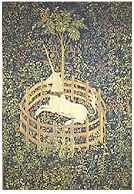
the archetypal mythology of horses
Copyright
2004-2021
Beverley Kane, MD
Page 13 of 20
selves are by definition unique and unlike any other. So the more we develop and
discover our personal truths and passions, the more we experience the isolation of setting
ourselves apart from our former selves and from others. The ultimate sacrifice in
personal growth is giving up a sense of belonging, even if it is belonging and being
beholden to a set of sanctioned behaviors that is not true to one's own nature. Yet
ironically the search for authenticity is the most unifying feature of existence. It is the
quest that restores the ultimate sense of belonging to and in an abundant, miraculous, and
benevolently evolving universe.
We project selflessness and altruism onto religious figures such as Mother
Theresa and other ascetic and celibate spiritual leaders and onto heroes such as the
firefighters who lost their lives in the World Trade Center. We project victimization on
abducted children, injured animals, and those who suffer from diseases, such as breast
cancer and AIDS, that have inspired various causes célèbres, postage stamps, and fun
runs. In the mythology of karma, a soul chooses to be born into a life of hardship and
disability to teach humanity about sacrifice.
Horses have always willingly sacrificed for their
human companions. Mohammed was said to have corralled
100 horses and withheld water from them for three days in the
desert. When they were half-crazed with thirst, he let them
out. As a test of loyalty, he then ordered the horn of battle to
be sounded. All but five horses ignored the call. These five—
all mares—who denied themselves in order to answer the
battle cry became beloved of Mohammed. They were known
as The Five Mares of the Prophet and their foals were deemed
asil –pure of blood.
A striking allegory of Willing Sacrifice is the unicorn
myth old by the third century Christians in the parables of the
Physiologus and their later representations in the bestiary
fables of the Middle Ages. The unicorn myth handed down
through Rome and translated and embellished across Western
Europe portrays the unicorn as a fierce and solitary beast. By
dipping his horn in water poisoned by the venom of the snake,
a symbol of the Devil, the unicorn purifies it for all the animals to drink. The unicorn
cannot be captured except by a virgin, who lures the unicorn into her lap. When he has
thus been lulled to sleep, the hunters spring out of the woods and stab the unicorn to
death. In some versions of the tale, he is resurrected by the juice of pomegranates,
symbol of life and fertility, and is given to the king.
The parable is likely an attenuated form of earlier Pagan myths in which the
charms that attract the unicorn are anything but suggestive of virginity. Yet the later
version was interpreted in Christianity to signify the Virgin Mary's attraction of the Son
of God, who incarnates, dies, and is reborn.
In animal sacrifice, including that of horses as in the asvamedha, humans are not
only sacrificing their own food to the gods, but are projecting their inner Willing
Sacrifice onto the animal. What other way is there to attempt to rationalize the cruel use
The Unicorn in
Captivity. 15c
tapestry. NY
Metropolitan
Museum of Art
|
 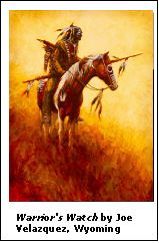
the archetypal mythology of horses
Copyright
2004-2021
Beverley Kane, MD
Page 14 of 20
of mares and the sad plight of PMU (pregnant mare urine) foals to produce estrogen for
human females?
Many of the living horses with whom we come into relationship have in a sense
sacrificed their freedom and bent their wills in order to bond with us as partners in work,
play, and discovery. We too enact the drama of willing sacrifice, giving up both luxuries
and even necessities to provide food, shelter, amusement, and companionship to our
horses and mucking out their stalls at 5 AM on a dark, freezing winter morning.
WARRIOR
A special subset of the Hero archetype deserves separate mention here because it is so
indelibly associated with Horse and set on horseback. From Genghis Khan to the Iliad to
cowboys and Indians, from The Lord of the Rings to El Cid to Ben Hur, the warrior
archetype holds for us notions of bravery, courage, justifiable
aggression, and glory. The bloody images of battle both
antagonize us with their violence and gore, and arouse us with
their massive displays of power and ruthlessness. Richard
Strozzi-Heckler, in his book In Search of the Warrior Spirit
describes his time spent training United States Special Forces
(Green Berets) and other top flight military troops in the art of
aikido.
*
He describes the nature of the true warrior when war
was a gallant hand-to-hand, horse-to-horse combat, not one
fought impersonally with missiles and guns and bombs and
other actions at a distance.
It is ironic that the wars fought today enact the failure
of the integration of the true Warrior spirit both by those who
fight and those who condemn the fighters. That is, hawks and
doves are eachother's Shadow archetypes. Pacifists do not
understand the basic human need to enact and integrate the Warrior. Warmongers
running unchecked use their armies for their own Shadow plays. They do so with hatred
and mass destruction that is inimical to the Warrior spirit.
Outward Bound and ropes courses, corporate paint ball fights, and contact sports
attempt to express healthy forms of courage and aggression, but there is nothing like a
good old fashioned war, where one's very life is at stake, to bring home the lesson of the
Hero and the Warrior, and their related archetype, Willing Sacrifice.
†
It is ironic that one
of the most prominent wars being fought today, that in Iraq, was formerly the
battleground of the most courageous and valiant war horses, fighting perceived infidels
then as now.
*
Strozzi-Heckler and his wife Ariana own horse ranches where Ariana teaches equine experiential
learning. The programs emphasize principles of somatics, martial arts, and the warrior spirit.
†
A popular computer software product is named Code Warrior—evoking the notion that nerdy little guys
who write code (computer programs) are capturing the warrior spirit.
|
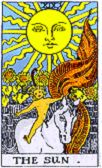
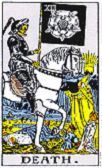
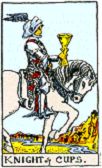
the archetypal mythology of horses
Copyright
2004-2021
Beverley Kane, MD
Page 15 of 20
HORSES IN THE TAROT—MYSTICAL CHIVALRY
The Tarot is a deck of 78 cards that, differentiating their upright from
reversed positions, depict 156 conditions of the psyche. The history of
the Tarot is obscured by ghost stories until the appearance of Italian
decks in the Middle Ages. In the absence of any objectifiable history,
the numerous decks must be taken at face value suggesting a
syncretism of multiple mythologies. Prior to the many PhotoShopped
desktop decks with pop and high tech imagery, the images and
traditions of the classical decks have been eclectically pagan,
Christian, Arthurian, alchemical, and Kabalistic.
In the Waite-Coleman Tarot, one of the most commonly used for divination,
there are seven cards depicting horses: The Sun, Death, the 4 Knights, and the 6 of
Wands. In all the illustrations, the horses are mounted, in portrayals of physical and
metaphysical transport.
In The Sun and Death, horses carry respectively the youngest
person and the oldest person in the Tarot—the crowned and
conquering child of the new aeon and the grim reaper himself. As in
many horse myths, the horse in the Death card is a psychopomp, one
who carries dead souls to their final resting place. The horses
contribute to the Tarot's framework of transition, cycles, and process.
In essence, the Tarot is like the Book of Changes, the I Ching, where
the only constant is change. The Death card in the Tarot, as death in
dreams, is one of the most reliable indicators and harbingers of
profound psychospiritual transformation.
Each of the four court cards represents the querent's evolving use of the energies
represented by the suits— wands (intuition), cups (emotions), swords (intellect), and
pentacles (sensation). Knights in the Tarot signify energies that the querent is in process
of integrating but has not fully mastered. The Knight's use of energy is,
in the chivalric sense, for the sake of the Other—the fragmented self
split off from the integrating ego who has not yet learned the mature
and confident use of that energy. In the mythos of chivalry, with its
values of courage, courtesy, honesty, courtly love, and service, the
Knight seeks his fortune in uncharted regions of consciousness. For
Waite, a 19th century mystic who was steeped in the esoteric
significance of the Holy Grail and who wrote books on the Arthurian
legends, Knights and their horses represent the Hero's journey to
spiritual wholeness.
SUMMARY
Horses are ubiquitous in the fables and legends of many different cultures. Like other
mythical figures, horses dramatize the Jungian psychological archetypes—roles or
|
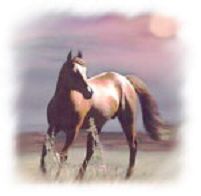
the archetypal mythology of horses
Copyright
2004-2021
Beverley Kane, MD
Page 16 of 20
caricatures derived from the experiences of a culture and present in the unconscious of
each individual within the society. Archetypes constellate the psychological
characteristics and identities that we unconsciously project onto other people, mythical
figures, and animals.
Horses also invite projections from the physical body—the somarchetypes that
constellate projected sensations of balance, speed, and strength.
When horses appear in dreams, one layer of the dream is the archetypal and
somarchetypal role of Horse. When we encounter horses in the flesh, our minds and
bodies consciously and unconsciously resonate with the stirrings of both psychological
and physiological archetypal energies.
|
 the archetypal mythology of horses
Copyright
2004-2021
Beverley Kane, MD
Page 17 of 20
ENDNOTES
1. Hippotherapy is the treatment by horseback riding of severely disabled persons by a
physical therapist, speech therapist, or occupational therapist. Therapeutic riding is the
schooling of high-functioning disabled persons by specially trained and certified riding
instructors. Equine-assisted psychotherapy is the treatment of psychopathological
disorders by licensed clinical psychotherapists, credentialed counselors, and life coaches.
Equine experiential learning, also known as equine-facilitated growth or equine-guided
education, is conducted by a variety of practitioners and guides for the purpose of
psychospiritual growth and transformation. All four kinds of horse therapies require
partnership with the horse and a horse handler, or equine expert, as partners.
2. In the passage quoted below, Jung describes the role of the physiological in
engendering symbolic systems: (my emphasis)
The symbols of the self arise in the depths of the body and they
express its materiality every bit as much as the structure of the
perceiving consciousness. The symbol is thus a living body, corpus et
anima. The uniqueness of the psyche can never enter wholly into reality, it
can only be realized approximately, though it still remains the absolute basis
of all consciousness. The deeper layers of the psyche lose their individual
uniqueness as they retreat farther and farther into darkness. Lower down,
that is to say as they approach the autonomous functional systems, they
become increasingly collective until they are universalized and extinguished
in the body’s materiality, i.e., in chemical substances. The body’s carbon is
simply carbon. Hence at bottom the psyche is simply world. In the symbol
the world itself is speaking. The more archaic and deeper, that is the
more physiological, the symbol is, the more collective and universal,
the more material it is. The more abstract, differentiated, and specific it
is, and the more its nature approximates to conscious uniqueness and
individuality, the more it sloughs off its universal character. Having finally
attained full consciousness, it runs the risk of becoming a mere allegory
which nowhere oversteps the bounds of conscious comprehension, and it's
then exposed to all sorts of attempts at rationalistic and therefore
inadequate explanation.
Jung, C.G. (1966) p. 173
In this passage Jung admits to a curiously Cartesian division of body and soul. One can
agree in that in zoological terms, the more physiological a symbol is, the more universal.
However, the physiological seems to holographically retain the characteristics of the
whole self. We speak of cellular memory, unique fingerprints, and experiences that are
held by the body and released in body work.
3. Michael Shea has assigned the Shadow archetype to the Body. He implies that the
psyche projects its Shadow onto the body.
The body is part of my shadow because it contains a long suffering history of
|
 the archetypal mythology of horses
Copyright
2004-2021
Beverley Kane, MD
Page 18 of 20
how the spontaneous excitement of life is killed, denied and rejected in
numerous ways until finally, the body becomes robotic and senseless. …
Touch therapists, body-centered psychotherapists and others who can read
the body will hear the recording of the rejected part of the self located in the
living tissue of the human body. It is the side too often denied or projected
onto others. …
As the 21st Century begins, the body, as shadow, becomes more
compelling. … The body becomes the repository of a lost mythology. This
mythology connects the living matter of my body to the earth and the spirit
world.
This concept is different from saying that the body itself projects unconscious material
outward onto, for example, horses.
4. There are several theories, none universally accepted, of how the Indo-Europeans and
their horses entered the historical record. There are mythic and counter-mythic academic
wars fought among cultural chauvinists (Indologists, Aryan supremacists, Marxists, etc),
feminist revisionists ("matrist historians" such as Marija Gimbutas) and their critics,
anthropologists, and linguists. The most cogent and agenda-inapparent meta-analyses of
the archeological and paleo-linguistic evidence as compiled by Mallory, Hayden, and
others suggest that the Indo-Europeans spread in several waves, by some combination of
invasion, slow migration with their own women and children, and diffusion with
acculturation, not necessarily in that order. Certainly if I had been a late Neolithic
farmer's daughter slopping pigs in the Pelasgians, I might have been quite attracted to the
dashing horsemen coming to trade in Corded Ware.
5. Modern man appears almost completely to have lost the ability to transmit
mental pictures, probably because this was the first skill he ceased to use
when he gained the ability to speak. If you could describe with your voice
what you were seeing, you did not need to transfer a mental picture. But
some primitive tribes still retain the skill and we have seen that Laurens
van der Post in his travels among the South African bushmen observed a
witch doctor gaze at the cave drawing of an antelope, throw himself into a
trance, and then so accurately describe the location where the antelope
was grazing that the hunters could go out and kill it.
Henry Blake, Talking With Horses
6. Von Franz, presumably following Jung's convention, refers to the four stages of the
anima and animus, as if there is a developmental sequence for each facet of the
archetype. In this hierarchy, the physical is trumped by the romantically esthetic
(emotional), which in turn is superceded by spiritual love (intuitive), which ultimately
gives way to wisdom. Examples from von Franz are, respectively, Gauguin's bare-
breasted Tahitians, Helen of Troy, the Virgin Mary, and the goddess Athena.
Other Jungians describe the chief manifestations of anima and animus as four
egalitarian functions—thinking, sensation, intuition, and emotion. The best description
|
 the archetypal mythology of horses
Copyright
2004-2021
Beverley Kane, MD
Page 19 of 20
of the facets are as Harding describes: Hetaera (beauty), Great Mother (compassion,
nurturing), Amazon (strength), and Wise Woman (seer) and Great Father (wisdom),
Hero (courage), Puer (frivolity).
7. There is an interesting difference here between the horse's physical capacity as a
somarchtype and as an archetype. When I feel the horse's body as an extension of my
own and as a compensation for my own waning strength as I age, I am projecting onto
the somarchtype of strength. When I look to a horse, typically a stalwart, older gelding,
to take care of me on the trail, I am projecting onto the archetype of Wise Father or
physical protector.
8. The Shadow is typically a person of one's same gender for whom one feels an
irrational hatred. A striking example of projected Shadow qualities is the murderous gay
bashing committed by homophobic heterosexual men. These men experience
uncontrolled rage when they see or imagine effeminate behavior in another man.
Because the perpetrators of these hate crimes have not embraced their own feminine
side—the softer, more nurturing, quiche-eating side that can cry in a tender moment—
they project Weak Woman as Shadow onto less macho males. Like the caricatured
effeminate-femininity pair, all negative Shadow qualities—even so-called evil—are
paired with a positive aspect of itself that needs to be integrated into the psyche.
BIBLIOGRAPHY
Blake, Henry L. Talking With Horses.
Edwards, Elwyn Hartley. The New Encyclopedia of the Horse. Dorling Kindersley.
London. 1994
Encyclopedia of World Mythology. Foreword by Rex Warner. BPC Publishing.
1970
Farrar, Janet and Russell, Virginia. The Magical History of the Horse. Robert
Hale. London. 1992.
Halpern, Mark. A Winter's Tale.
Hausman, Gerald and Hausman, Loretta. The Mythology of Horses. Three Rivers
Press. New York. 2003.
Harding, M. Ester. The Way of All Women: A Psychological Interpretation.
Longman's Green, 1933
Hillman, James and McLean, Margot. Dream Animals. Chronicle Books. 1997.
|
 the archetypal mythology of horses
Copyright
2004-2021
Beverley Kane, MD
Page 20 of 20
Jung, Carl Gustav. Psychological Types. Collected Works Vol 6. Bollingen 1921
— and M.-L. von Franz, Joseph Henderson, Jolande Jacobi, Aniela
Jaffé. Man and His Symbols. Doubleday. 1964
—
The psychology of the child archetype. In Read H., et al (eds):
Collected Works Vol. 9. Princeton: Princeton University Press.
1966
Kohanov, Linda. The Tao of Equus—A Woman’s Journey of Healing &
Transformation through the Way of the Horse. New World Library.
2001
-
Riding Between the Worlds. New World Library. 2003
Krishnananda (Swami).
The Brihadaranyaka Upanishad
krishnananda.org/brdup/brhad_I-01.html and hardcover book. The
Divine Life Society Sivandanda Ashram. Rishikesh, India.
Mallory, John P. In Search of the Indo-Europeans
McCormick, Adele von Rust and McCormick, Marlena Deborah. Horse Sense and
the Human Heart: What Horses Can Teach Us About Trust,
Bonding, Creativity, and Spirituality. Health Communications.
1997
Midkiff, Mary D. She Flies Without Wings-How Horses Touch a Woman’s Soul.
Delacorte Press. 2001
Shea, Michael J. The Body as Shadow. http://www.sheacranial.com/publications/
papers/paper_bas.htm 2000
Sheppard, Odell. The Lore of the Unicorn. Harper & Row. New York. 1979
Strozzi-Heckler, Richard. In Search of the Warrior Archetype.
Sylvia, Claire. A Change of Heart. Warner Books. 1998
Taylor, Jeremy. Dreamwork. Paulist Press. New York. 1983
-
The Living Labyrinth. Paulist Press. New York. 1998
Witter, Rebekah. Living With Horsepower! Personally Empowering Life Lessons
Learned. Trafalgar Square. 1998
- Winning With Horsepower! Achieving Personal Success Through
Horses. Trafalgar Square. 1999
|